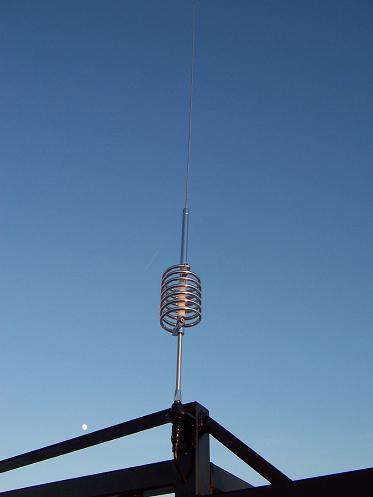    
Tech833
Moderator
Username: Tech833
Post Number: 1808
Registered: 8-2002
| | Posted on Friday, January 29, 2010 - 3:49 pm: | 


|

Workman SP-3000 antenna review
‘Trucker’ style antennas are those having a 3/8 inch, 24 thread stud and typically fall into one of two categories- Helical fiberglass, like the Firestik, and base or center loaded metal. Fiberglass antennas offer flexibility and vibration resistance, as well as being inexpensive. They lack power handling capability and bandwidth (for those who want to travel outside the CB band).
The Workman SP-3000 is made from various large, construction grade materials. The lower shaft is round, solid stainless steel, threaded on the bottom with a collar threaded up the 3/8-24 threads, jam fit against the unthreaded part. The coil appears to be chrome plated copper tubing, while the insulator is a stiff nylon derivative. The upper shaft feels like chrome plated brass coupled to a flexible, tapered stainless steel whip. Some hardware holding the antenna together looks like chrome plated brass castings.
I experimented with the Workman SP-3000 on a few different vehicles to measure the bandwidth. I had no trouble at all tuning the SP-3000 for the 10m amateur band so I could legally use up to 1500 watts of power for some real-life on air testing.
In every installation, a low SWR was quick and easy to obtain. The Workman SP-3000 is not picky about coax cable length like some other ‘trucker’ style ungrounded type antennas. A ‘flat’ 1:1 SWR in the center of the CB band would give a similar ‘flat’ SWR on the outer edges in every installation scenario tried. The Workman SP-3000 has a very low Q coil, which increases the overall bandwidth of the antenna compared to the popular helical wound fiberglass antennas. In fact, of all the ‘big coil’ antennas tested, the Workman SP-3000 had the lowest Q and best bandwidth. The less than 2:1 SWR curve in one sweep was just under 3 MHz. wide. And, the round tubing coil looks better and has less wind resistance that the flat aluminum coil material seen on a lot of other big coil antennas.
One thing I would like to mention before we move on- As it arrived, the Workman SP-3000 was very well built and assembled. However, I was able to obtain even better bandwidth performance from the antenna after completely disassembling it, cleaning all metal-to-metal joints, and applying Penetrox to all joints before re-assembly. A measurable improvement in bandwidth was obtained, and a slightly lower RF resistance from tip to tip. If you plan on using your SP-3000 in any kind of demanding situation, I highly recommend performing the same treatment before using.
At highway speeds, the Workman SP-3000 lower half does not flex at all, but the tip of the antenna deflected about 20 degrees from vertical. The stiffness of the lower half of the Workman SP-3000, means if it strikes an object like a low tree branch, it WILL break something. I put a 4-inch heavy duty spring under the Workman SP-3000 and it stayed vertical up to about 60 MPH. The Workman SP-3000 is quiet at highway speeds- no whistling. If you want the upper half of the antenna to stay more vertical, I found that a K40 baseload whip is a tight, but comfortable fit in the Workman SP-3000. Since the K40 whip is stiffer, and non-tapered, it flexes a lot less than the whip that comes with the SP-3000.
On-air testing showed tremendous performance improvements in both transmit and receive over a short Firestick. The performance boost is more noticeable when tuning into the 10m amateur band. The Workman SP-3000 does not require retuning for receive into 10m, but the Firestik gets really deaf outside the CB band and was almost useless on 10m, even for receiving only. In band, signals were typically 1 or 2 s-units better on transmit and about 2 s-units better on receive. On the range, gain was measured at -2.9 dB compared to a ˝ wave dipole antenna.
For those with super-power in their cab, the Workman SP-3000 will handle about anything you can dish out. Running full legal limit on the 10m amateur band of 1500 watts, I was not able to raise the temperature of the antenna in any measurable way. I am sure the Workman SP-3000 could handle several thousands more watts than I was able to test it with.
If you add a 4” heavy duty spring to the SP-3000’s mount, you need to shorten the whip by about 1-5/8 inch, in my tests. There is over 6 inches of travel in the whip mounting stud, so you can make radical adjustments easily, and repeatedly.
The fit and finish of the Workman SP-3000 antenna is very good. There are no welds, so that means a lot of hardware to hold things together. The stainless steel whip is held by two grub screws. For UV resistance, while I had the antenna disassembled, I went ahead and formed a piece of black heat-shrink tubing over the white nylon insulator, which improved the looks, and also added some overall stiffness.
The Workman SP-3000 is the least expensive of all the big coil antennas currently available, and has the best bandwidth of all the antennas I have measured so far. For the price, the Workman SP-3000 is, by far, the best buy.
-Tech 833
Your radio 'Mythbuster' since 1998
|



